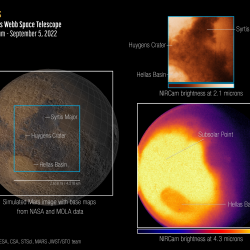Encyclopédie
From reporting a halo and dark spots to CO2 and other constituents discovered with instrumental techniques.
Venus' atmospheric composition in percentages show 96,5% of CO2 and less than 3,5% of N2.
Venus’ atmosphere has a thick cloud layer that covers the planet, extending from 30 to 90km.
Venus clouds (containing sulphuric acid) have been observed in the Ultraviolet UV and Infrared IR.
Venus was a prime target for space missions and probes in the 60s, 70s, 80s, 90s and 2000s.
First European mission to Earth's nearest planetary neighbour, Venus. Scientific objectives.
Venus displays phases like those of the Moon. Galileo observed the phases of Venus and endangered Ptolemy’s system centered on the Earth.
Seasonal changes on planet Venus are very small due to small axial inclination.
Radar research showed a young flat surface with mountains, plains, high plateaus, volcanoes, crest and impact craters.
Two regions in the atmosphere of Venus show completely different thermal properties.
The rotational period of Venus on its own axis is very slow. With a retrograde rotation, the planet orbits the Sun in 224.7 days.
The two planets are very similar, but a detailed comparison shows the differences.
Questions about the internal and external core of planet Venus remain open: temperature, liquid, solid state analyses.
The Venusian cloud layer makes one complete tour of the planet in 4.2 days, with wind speeds of 540km/h.
The very high surface temperature of 474 °C hardly varies from the sunlit side to the night side.
The planet Venus used to have lots of water, that has been completely evaporated. CO2 remains in the atmosphere of Venus.
The ash and the gas sulphur dioxide (SO2) emitted by volcanic eruptions are a major hazard to aircraft.
Venus missions show us thousands of volcanoes, well preserved by the atmosphere of Venus.

